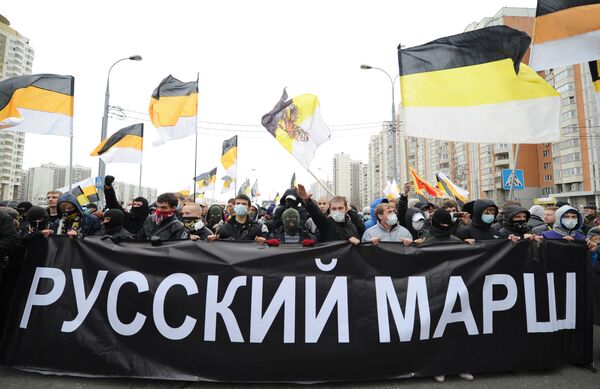The scene on Friday afternoon in the working-class neighborhood of Liublino was troubling: thousands of masked, ultranationalist youth, shouting obscene and anti-immigrant slogans, stormed through the area under the haze of smoke bombs, flares and blasting music, while a police helicopter hovered above to keep a watchful eye on events that could have very quickly turned violent.
Urging their compatriots to “take back Russia,” they marched in columns along closed-off streets, waving the original black, yellow and white flag of the Russian Empire and making clear their vehement disgust for the Muslim immigrants they blame for stealing their jobs, snatching away their government, and displacing them in their own country. Most appeared to be the young, middle-class soccer hooligans largely responsible for the deadly ethnic riots in downtown Moscow last December. Also strewn throughout the crowd, however, were the bearded, muscular Slavs, decked out in either Cossack attire or late Tsarist-era military regalia, who could easily be the poster children for the “pure” Russian nation.
It was the seventh annual Russian March, a mass celebration of the Day of National Unity – perhaps the biggest day of the year for Russian ultranationalists. Yet the crowd, numbered in the several thousands (lower estimates placed the attendance around 5,000, while higher estimates said up to 25,000), didn’t seem to celebrate their Russian identity as much as condemn Caucasian and Central Asian immigrants for diluting it. What’s more, the demonstrators, loosely bound through several different ultranationalist and seemingly anarchist organizations, couldn’t quite agree on a platform. Between chants of “When we’re united, we’re invincible!” were shouts of “Get rid of Putin!” and “Down with the party of crooks and thieves!”
The dizzying mix of anti-immigrant, anti-government and, it seemed, anti-everything propaganda left me wondering what exactly they were representing. When I caught up with a peculiar-looking supporter, a 70-year-old bearded and visibly weathered man who introduced himself as Yuri Aleksandrovich, I hoped he would provide a bit more clarity – some aged wisdom, if you will – on the march’s intended goal. Instead, I was offered the same, seemingly ambiguous rhetoric most of his 20-something-year-old juniors espoused.
“Today, we’re living in a colony. We’ve been colonized, occupied, and taken over by these people,” he said. “Our government has been seized from us.” He pointed to examples, such as the Caucasian republics and Tatarstan, among others, where national autonomy has been “usurped” from the Russians by a titular – and indigenous – nation. “We want to show that among the many ethnic minorities here, there is a Russian nation that created, defended and built up the state – it is our Russian state.” I couldn’t help but recall the well-worn phrase that points to the inherent multicultural nature of the Russian identity: “Scratch a Russian, and you’ll find a Tatar.”
Perhaps even more disconcerting was observing the dichotomy between the rowdy, beer-swigging marchers and the stoic, if slightly miserable, policemen lined shoulder-to-shoulder along the entire route. Bussed into the area en masse in rusty troop transports, many of the officers themselves appeared to be of non-Slavic origin. As they stood and watched the crowds shuffle by – yelling slogans like “Grozny [the Chechen capital] will soon become white!” – I almost felt a sense of sympathy for these likely underpaid officers forced to tolerate the mass bigotry. If riots did break out, I wondered, whose side would they be on?
As the march approached its end destination, where the organizers – among them anti-corruption raider Alexei Navalny and Slavic Union head Dmitry Dyomushkin – staged a relatively weak and uninteresting concert, the demonstrators broke apart and headed their own ways. As ultranationalist leaders took to the stage one by one to say their bits, only several hundred of the remaining marchers seemed interested. Many of the others hung around to drink a few beers with their friends (oddly enough, one of the slogans chanted earlier was “Russian means sober!”).
At that point, if not earlier, it became clear exactly how fickle the entire operation was. These young, disenchanted Russians seemed less intent on affecting change in the political system than they were in complaining about it. And, in any case, what’s there to complain about? The ultimate irony of it all was simply watching the hordes of allegedly disadvantaged Russians looking to “take back” their jobs, their country – all the while marching in expensive sneakers and snapping photos with their iPhones.

